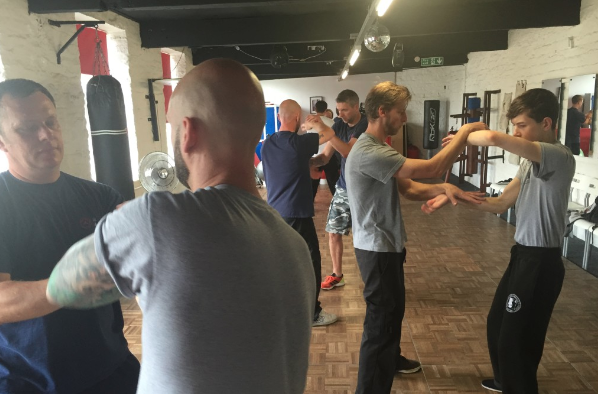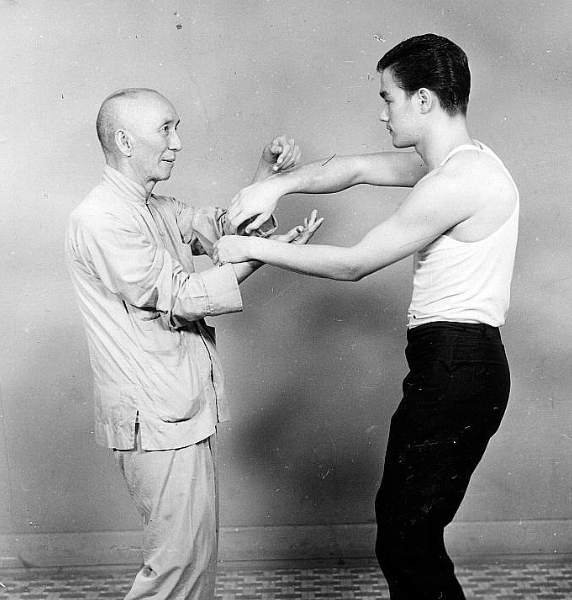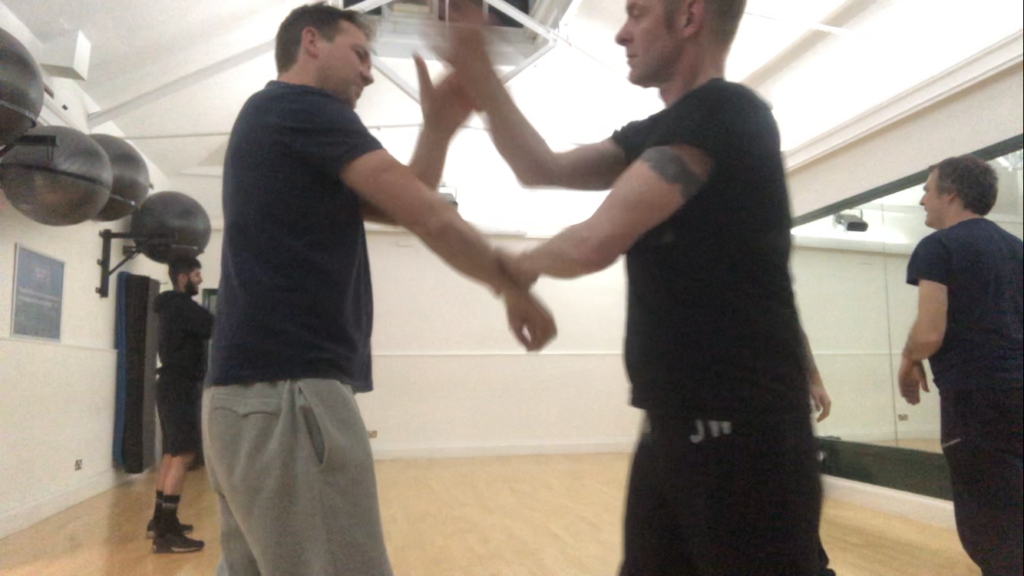What is Wing Chun Chi Sau? Wing Chun is a style of Kung Fu which is based on economy of motion and minimum movement. Chi sau is a sticking hands practice used in Wing Chun as a training exercise which helps to develop good positions, use of energy, reflex response and techniques. In Chi Sau, each practitioner attempts to disrupt the others balance or positions and land a strike. To do this without compromising one’s own defensive positions is the key. This leads to a “game” much like chess, where each person refuses to allow an attack to be landed.
To stop all attacks from landing you need a lot of experience of chi sau. This is more difficult to obtain with only one partner. So having multiple training partners is beneficial to your learning experience. See also private self defence versus classes.

Wing Chun Chi Sau
Chi sau basics involves three main positions: tan sau, bong sau and fok sau. By alternating through the three positions relative to your partner’s positions, you can build a defensive barrier which stops your partners attacks. The main “rule” in chi sau is not to land an attack when it compromises your own defensive positions. If you were to reach over your partners positions, in order to land an attack, they could easily counter strike.
With this structure in place, Chi Sau becomes a game of attempting to displace your partner and compromise them in some way so as to land a hit while continuously defending.

Wing Chun Chi Sau – Drills
There are some basic hand drills which can help you understand Chi Sau. Dan Chi Sau (Single sticking hand) is one of them. In dan chi sau you only link arms with one hand to make things simpler. The initial attack in instigated from the tan sau position which becomes a palm strike. The response is a jut sau to stop the attack. When the attack is nullified by the block, you must stop attacking immediately. This teaches you not to over commit an attack which has been nullified.
Once you understand this concept, your defence gets better because you’re only attacking when you’re “safe” from counterattacks. You don’t over commit an attack and you become hyper sensitive to your partner’s responses. This gives you the ability to attack fully when there’s a gap, but maintain your defence when an attack would be ineffective.
Lap Sau
Another Wing Chun drill is lap sau (pulling hand) drill. In this drill we train a number of automatic reflex movements. This includes the elbow reaction to an incoming attack and the retrieval of the back hand (to avoid a trap). Once these reflexes become automatic, the drill can be speeded up and power can be added.
In chi sau, the elbow reflex is the best way to stop a short pull of the arm towards an incoming punch. Lap sau drill also teaches some other fundamentals which are useful for chi sau:
- Elbow position (during the pull phase as well as for defence against it) – controlling centreline throughout.
- Back hand retrieval – pinning the hands is used extensively in chi sau so this teaches the defence of such an attack
- Control of centreline during movement – typically as you move through the positions you will expose your centreline to incoming attacks. This can be tested thoroughly in lap sau exercise
- Turns – during lap sau drill you learn how to turn, moving the head off the centreline away from the attack.
- This allows the hands to be more relaxed – tense hands can be more effectively manipulated so awareness of tension is a bit part of the drill
Pak Sau Drill
Pak Sau (slapping hand) drill is used to break a contact and attack down the centreline towards your opponents jik seen – centreline. It is a block “removal” technique which breaks a contact with a small hand movement. Once a gap is created in your opponents defence, you strike towards your opponent at the moment the gap appears.
Pak sau exercise is useful for Chi sau development because it allows you to attack while defending. As you attack down centreline, you should also cover opportunities for your opponent to counterstrike. This is a useful drill which helps you focus on defence while attacking so as not to compromise your positions in the midst of attacking. So while attacking with pak sau techniques you should also be pinning your opponents arms (trapping hands).
Poon Sau
Poon sau is another important drill for chi sau development because it helps you maintain perfect position while rolling and changing from one position to another. This is often when gaps appear and your opponent can take advantage of a poor position (and attack towards your centreline). Poon sau means “rolling arms” and is a form of chi sau but without attacks. So doing this exercise (with the right mindset) can help you stay relaxed while changing positions with a focused regard for centreline.

If your opponent pushes your position out, for example, you can easily change to the inner position without tensing up. If you tense and fight against your opponent (with tension) this can easily be used against you to create an opening. When your changes are sloppy, another opportunity appears to attack when you are too loose with your changes. So the key is to have good positions and tight changes which don’t allow your opponent to create a gap. You stay relaxed throughout and don’t offer any tension, which also could be used as an opportunity to attack.
Summary
Wing Chun chi sau is like a fight being put into a “game” whereby each practitioner can understand simultaneous attack and defence scenarios in a safe environment. By understanding the basic chi sau drills of dan chi sau, lap sau, poon sau and pak sau, your chi sau develops into an intuitive gameplay where defence and counter attack becomes automatic and unconscious.
Chi Sau can be broken into other “chunks” such as dok sau (investigative hands) or gor sau (attacking hands). By changing the environment in chi sau – such as forcing one person to only defend, for example, or not step backwards, you can develop different elements of the gameplay and build a greater understanding of it over time.
Once you understand chi sau in basic terms, you naturally tend towards the actions and movements which work for you the best. You use the techniques you become good at. This can mean you neglect those which you’re unfamiliar with. So it’s useful to continually change up your chi sau framework by removing your “favourite” techniques. This forces you into unfamiliar territory and therefore helps you continually develop your Wing Chun through chi sau practice.
“Empty your cup so that it may be filled; become devoid to gain totality.”
― Bruce Lee

Comments
8 responses to “Wing Chun Chi Sau”
[…] you enjoy. I’ve been a Wing Chun pratitioner for several years and hugely enjoy playing chi sau with my […]
[…] practice of chi sau, you will encounter moments of conflict with your partner. It is during these moments where you are […]
[…] Chun uses an interactive “play” of chi sau, a sticking hands practice. This interactive drill allows you to learn instinctive movements based […]
[…] also Wing Chun chi sau for more in depth reading on Chi […]
[…] The “heart” of Wing Chun is Chi Sau (Sticky hands practice). This is where you can practice your movements against a “live” opponent to develop sensitivity and use of energy. See also Wing Chun Chi Sau […]
[…] remember, Wing Chun gives you direct attacks and the know-how to implement them through it’s Chi Sau (sticky hands) […]
[…] need time to learn the basic pattern drills which give you a natural and automatic response in Chi Sau (sticky […]
[…] quarters self defence in a safe way. It can be likened to putting a fight into a game format. In chi sau you learn basic defensive positions which are then pressure tested with your opponent. You learn to […]